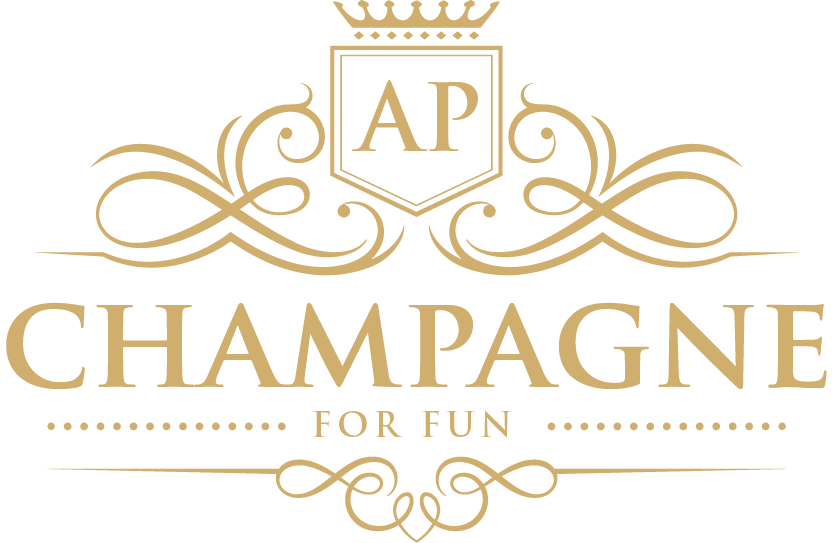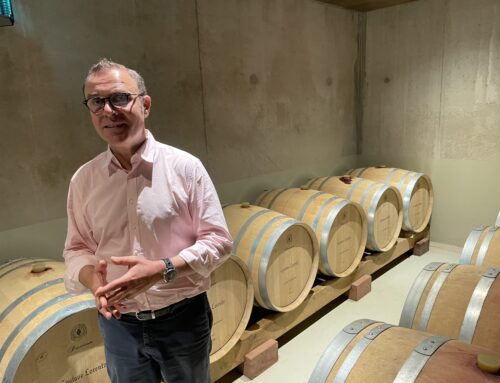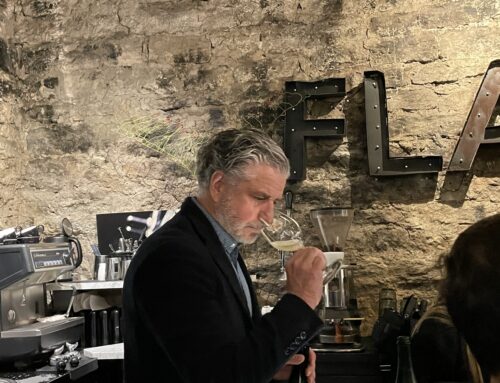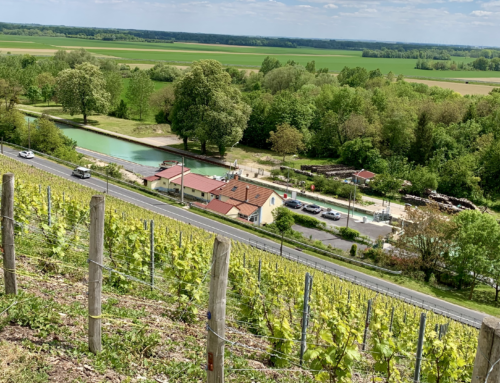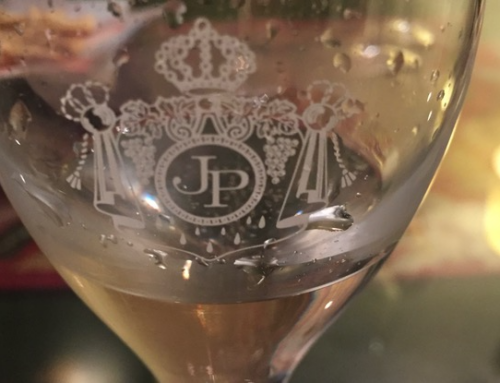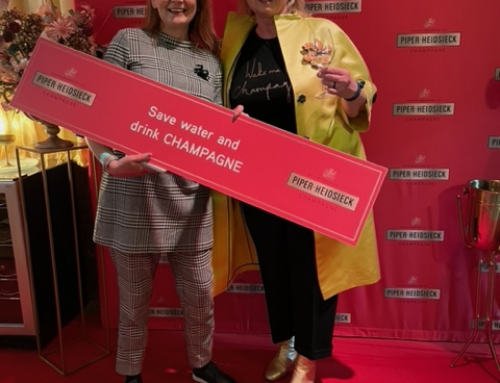Dom Pérignon is still here. Champagneforfun with Mr Kristjan Markii
Champagne for fun. The next door, the next mysterious staircase and, a surprise. We are welcomed at the door by a guru. No, not Dom Pérignon himself, but by someone who in Estonia is none the inferior of the world-famous monk. The next nocturne takes place with Estonian Sommelier Association president Kristjan Markii. Over the last year, I have used a newcomer’s brazenness at every opportunity, and at every seminar, tasting or dinner I have asked and asked and asked Kristjan questions. As Kristjan leads us to the next surprise, I tell myself: not today. In my mind, I waggle a finger in admonition to myself: today you won’t ask your questions. Just try to listen and enjoy.

Kristjan Markii, Dom Perignon and champagne for fun
Neoclassical Frédéric Vardon
But if it’s in your nature, you can’t go against that. Since I’ve decided to spare Kristjan, I set a course for the open kitchen. From of his domain, Frédéric Vardon looks out at the crowd of people with curiosity. I think most people would recognize that magician. We embrace. Frédéric is the chef at LE 39V in Paris. Location: 39 Avenue George V Paris. The other LE39V is in Hong Kong. Why travel to Hong Kong if there’s a LE 39V in Paris? Because of the 101stfloor. You can imagine the views.
Frédéric Vardon, too, is closely connected with Alain Ducasse: 14 years working together.
Frédéric Vardon has a special philosophy. Is it a food philosophy? I don’t know. Is it a philosophy at all? I don’t know, maybe it is a life-motif. I feel at home in Vardon’s world because he doesn’t consider it improper to share his food with others. His aim is to turn source ingredients into an experience that people want to share. And by sharing he doesn’t mean social media.
Can I try something off your plate?
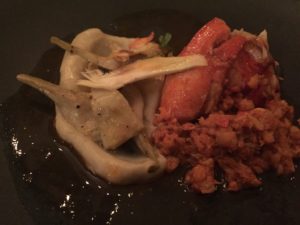
Champagne for fun with neoclassical lobster
Neoclassical lobster in the city at night
The culture of sharing food is quite common in Estonia. My partner and I always agree on what each of us is ordering so we can later share it, to get as many different experiences as possible from the art. But for example, in the US you might invite a hysteric fit or the fear of death from your companion if you approach their plate with your fork. It’s viewed in the same light as spitting on someone’s food, because your fork has been in your mouth, touched your saliva. And you can’t root around in a serving dish with your own fork, either. It’s called double dipping. Again, your fork is dirty because it’s been in your mouth. It’s good to know if you go out to eat with a friend from the States. You shouldn’t grab something off their plate or the platter with your own fork, or God forbid, your fingers. For us, Finno-Ugrics, sharing culture is more in our blood. I always become cross when the sharing means that if I ordered something that turns out to be a hit, it is gobbled down quickly leaving me only with a plate I can lick. But Frédéric Vardon considers sharing the ultimate accolade for a chef. For a culinary artist, it’s important where they get their ingredients from; they prefer knowing the farmer whose farm the milk or butter comes from.
Wine is not produced; wine is grown. Dom Pérignon P2
Frédéric Vardon is a chef who has a high regard for the sommelier’s contribution to the food experience. Wine completes the food. I quote: “Wine isn’t produced, it’s grown or raised like we raise animals, we treat wine like we treat people.”
Fréderic Vardon’s ideas are important enough that they should be read in the original or the English translation on his website.
Neoclassicism in the gourmet world
Frédéric Vardon’s neoclassical cookery is a trendsetter throughout the world’s gourmet landscape and chefs in many kitchens are quite enthralled by historical French cooking in its modern trappings.
The return of French neoclassicism as the new minion of the culinary world is perhaps connected to the spread of Instagram. Food has to be photographable and sharable. In this instance, I mean social media sharing. Food has to be photogenic, with light and shadow, different textures, geometric form and neutral palette. Instagram feeds off food as much as it does fashion. Or even more.
You probably know the one where the waiter asks the restaurant patron:
“Excuse me, don’t you like our food?”
“Of course, why do you ask.”
“You started eating and didn’t take any pictures.”
Neoclassical lobster with artichoke
Back to the medieval city’s walls where the famous monk is waiting impatiently. On the plate is lobster, accompanied by artichokes that are well done, raw and tempura. A yellow wine sauce to put the final touch on it. Yes, yellow wine sauce, not white wine or orange wine sauce. A big winter feast is about to begin here, so tempura in its original meaning isn’t very welcome. Temporaoriginally meant a fasting food. Originally from Portugal, temporasignifies fasting rules. The rules permitted fish, but over the twists of history, the word that signified those rules have come to mean a way of preparing fish. A crisp crust of fried batter that encloses the morsel of food. The batter is made with ice-cold water, and the bowl with the batter is kept in an ice bath.
Vin Jaune
What is yellow wine? Vin Jaune is made from Savagnin grapes. Savagnin grapes originate from the Traminer grape variety.
I consider that back when I used Veuve Clicquot brut to make a dish of Christmas sauerkraut, maybe it wasn’t such a brutal deed. My diners did ask me why I didn’t use Dom Pérignon if I’d already decided to throw money around. But Dom Pérignon hasn’t been a part of culinary arts, not neoclassical, not even the neoromantic direction. In dabbing a drop of sauce on my plate with my fork, my back straightens up with self-confidence: you don’t make a sauce from a undrinkable wine. Tonight’s course in the company of the famous monk features a sauce made from a wine at least seven years old. The yellow wine is somewhat reminiscent of sherry. Making the wine is complicated and requires constant vigilance to keep too much acetic acid from forming. First the savagnin cuvee is allowed to ferment peacefully for 18 months, then it is placed in 228-litre Burgundy oak barrels. The French oak barrels – both the Burgundy and Bordeaux type – are 225-228 litres because this size allows a single person to move a barrel. It doesn’t hold the entire 228 litres of wine; air is left for the surface yeast – the flor– to develop. But it isn’t sherry that’s being made here, even though an analogous method is used. From that point, the barrels are used in the same way as in the process of making vin santo. Different temperatures are brought to bear on the barrels. After these manipulations, the yellow wine is bottled in clavelins.
Kristjan and an old monk
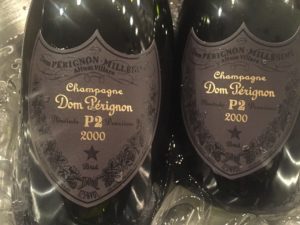
Dom Perignon P2, champagne for fun
We have Dom Pérignon P2 2000 in our glasses – a champagne that has reached adulthood. Do you remember what the weather was like in the year 2000? Or what you were doing that year? In Champagne, France, the weather was, as it always is, complicated. Cold and rainy, warm and stormy. The ideal vine-ripening weather set in only in August and lasted until the end of the harvest.
Kristjan talks about how with a poor quality glass, people can kill off a champagne with a beautiful soul. At the same time, a flutter of fairy wings is heard from the glass, as the fine bubbles seek their place. I stick my nose in the glass – hmmm, again some smokiness can be discerned. A smoky smell is something I enjoy, it contains a multitude of stories, depending on the beverage in the glass. If one could describe bonfire smoke with the word “elegant”, elegant smoke is that which pampers the nose. And orange blossom, then orange peel warm from the fire, brioche. Plum can also be detected, but my nose is mainly able to block out that aroma. I just can’t stand plums. Prunes remind me of angry, embittered people with black-and-white attitude. Fresh plums on the other hand, no matter how good they look, spark an association with gastric distress. As it takes immense mental effort to place all this into a pleasing pattern, my nose does a favour for my brain and blocks out the plum smell. My brain knows it’s there but doesn’t sense it. The aroma from the glass tells of a bonfire on the seashore, a rustling of sea-oats under a coat spread out as a blanket, brioches under a towel in a picnic basket and an orange in the hand of the man tending the fire. One might scent a moment of romantic freedom.
The flavour is slower to reveal itself. The olfactory experience does not yield easily and the gustatory sense adds its trumpets to the overall symphony gradually. Ta-ta-taa! Although Dom Pérignon is credited with saying that he drinks the stars, it isn’t the stars in the sky that are on the tongue in the case of Dom Pérignon P2 2000, not at all. The starry sky opened up in the perfume. Now a bit of animality, a sense of sea and minerality come into play, and white berries and liquorice release their laughter in the mouth, notes of roasted malted grain reinforce the smoke.
Brimming with experience
The gustatory experience with the artichoke and lobster framing the Dom Pérignon P2 2000 is an unbelievable experience. It has to be so, because the senses have gained a strong experience in previous champagne houses, with other flavours and aromas. It is hard to enrich one who is already saturated with experience with new experience.
But it seems that the old monk Dom Pérignon and Hanna have decided to organize something that very few of us would have been able to anticipate or even imagine. My thanks go out to Kristjan Markii and Frédéric Vardon. We fall into line behind Hanna. The cold wind on the dark street blows away a part of the olfactory experience, but still, it seems to me that is all it does. I am saturated with emotions up to the limit. I feel that nothing more could possibly fit in my soul. But Prike Eesti, who is organizing this nocturnal adventure, begs to differ. Hanna Laasmägi strides in sanguinely through the next door, heavy with history.
Hanna provides the cue: Let’s rise now, new doors await!

Hanna says: it’s time for next champagne for fun
Champagne: Dom Perignon P2 2000
Manufacturer: Moët&Chandon
Region: Champagne
